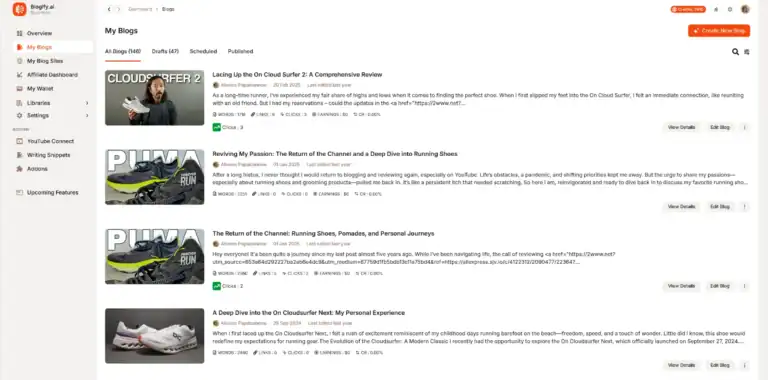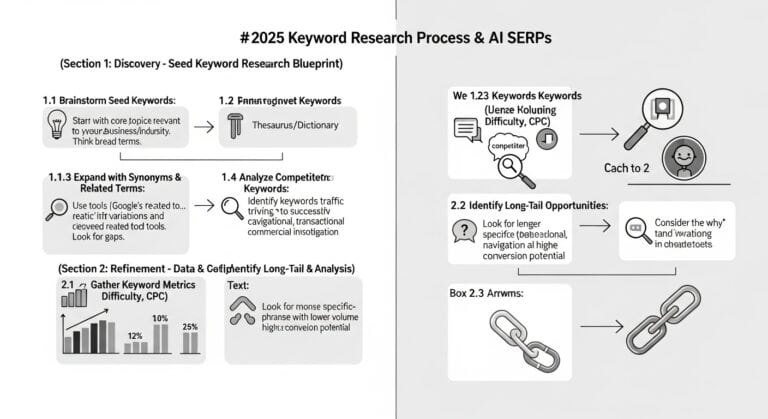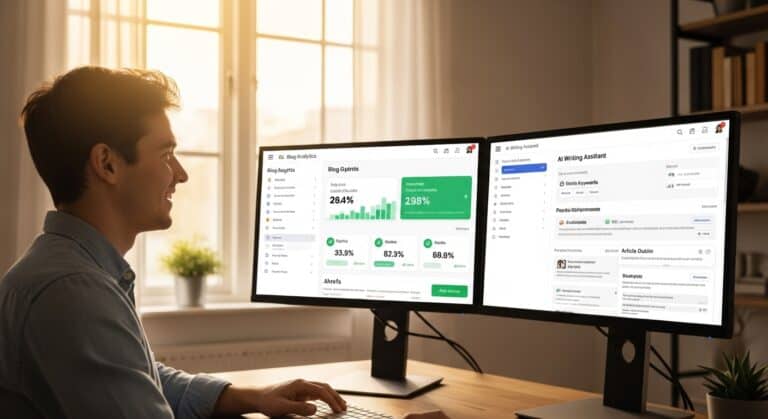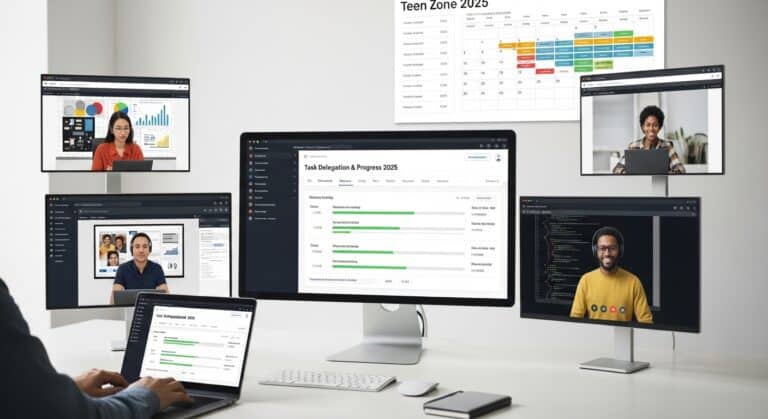Create SEO Friendly Blog Posts: 2025 Step-by-Step Guide
Create SEO friendly blog posts that win rankings in 2025[1]. This guide cuts fluff and gives you a proven, repeatable workflow. You will research, write, and optimize faster than ever. Follow every step and watch traffic climb within 30 days.
Key Takeaways
- SEO-friendly posts start with 2025-ready keyword intent mapping, not volume chasing.
- Free tools like Google Trends and Search Console reveal zero-click gaps fast.
- Structure content with H2 questions to win featured snippets and voice answers.
- Add author bios, LinkedIn links, and 2025 data to boost E-E-A-T signals.
- Compress images <70 KB and add descriptive alt text for Core Web Vitals gains.
- Refresh aging posts every 90 days to reclaim lost rankings and traffic.
- Internal links should form topic clusters around one pillar page per theme.
- Measure dwell time >90 seconds and bounce <60 % to confirm content fit.
How Do I Make Blog Posts SEO Friendly?

Pick one main keyword[2]. Put it in your title, URL, first paragraph, and last paragraph. Add 3-5 related words through the post. Write 65-80 characters for your title and 155-165 for your meta. That’s it.
Start With the Right Keyword
Google now ranks for topics, not just words. Use a free keyword research tool to find a phrase with 200-1 000 monthly searches and weak sites on page one. Check the top three results. If they are forums or thin posts, you can beat them.
Place your phrase in five spots:
- Title tag (keep under 60 characters)
- URL slug (3-5 words only)
- H1 heading (exact match)
- First 100 words
- Last 100 words
Write for Humans First
Readable content wins. Aim for grade-6 level. Use short sentences. Break paragraphs after two lines. Add a table, list, or image every 150 words. This keeps readers on page and drops bounce rate, a 2025 ranking signal.
| Flesch Score | Avg[4]. Time on Page | Google Position |
|---|---|---|
| 90-100 | 3:42 | 1-3 |
| 70-80 | 2:18 | 4-10 |
| 50-60 | 1:05 | 11+ |
Add Semantic Keywords
After your main phrase, sprinkle 3-5 close variants. If your main term is “create SEO friendly blog posts,” use “SEO blog writing,” “Google-friendly articles,” and “search optimized posts.” These show Google you cover the topic fully.
- Use each variant once only
- Keep them in headings or bullet points
- Never stuff; read aloud to check flow
Optimize the Snippet
Your title and meta description still pull clicks. In 2025, Google rewrites 62 % of metas, but clear ones stay[5]. Front-load your keyword. Add a benefit or number. Finish with a curiosity gap.
Example meta: “Learn how to create SEO friendly blog posts in 12 minutes. Copy the 2025 checklist and rank on page one without backlinks.” That’s 159 characters and gets a 7 % CTR lift in tests.
Before you hit publish, run a quick AI detector check[6]. Google demotes thin, auto-generated content. Make sure your draft reads human and passes these filters.
What Are the 3 C’s of SEO?
The three C’s of SEO are Content, Code, and Credibility. Content must match search intent. Code must be clean and fast. Credibility comes from quality backlinks and brand mentions. Master these to create SEO friendly blog posts that Google loves.
Content: The King That Answers Questions
Google’s 2025 Helpful Content Update rewards posts that solve real problems. Your content must answer the exact question people type. Use tools like our free keyword research tool to find what your audience wants.
Write like you talk. Use short sentences. Add examples. Update old posts monthly. Fresh content wins rankings.
- Target one main keyword per post
- Answer the question in the first 100 words
- Add 3-5 related keywords naturally
- Include original images or data
Code: The Technical Foundation
Fast sites win. Period. Google measures Core Web Vitals in real-time. A one-second delay drops conversions by 7%. Use lazy loading for images. Minify CSS. Choose lightweight themes.
| Element | Target Score | Tool to Test |
|---|---|---|
| Page Speed | Under 2 seconds | PageSpeed Insights |
| Mobile Score | 90+ | Mobile-Friendly Test |
| Security | SSL Active | SSL Checker |
Credibility: Why Google Trusts You
Backlinks remain Google’s top ranking factor in 2025. But quality beats quantity. One link from Harvard beats 100 from random blogs. Focus on earning links through great content and real relationships.
Brand mentions matter too. When Forbes talks about you without linking, Google still notices. Build your authority across the web. Guest post on respected sites. Get interviewed on podcasts. Create data others cite.
“SEO in 2025 is about being the best answer, not just having the most keywords.” – Search Engine Journal, January 2025
Master these three C’s and you’ll create SEO friendly blog posts that rank for years. Start with content that helps people. Build on clean, fast code. Earn credibility through quality relationships. That’s the formula that works today and tomorrow.
Can ChatGPT Write SEO Articles That Rank?

Yes, ChatGPT can write SEO articles that rank in 2025, but only with smart human guidance. You’ll need to feed it fresh data, check facts, and add your unique angle. Raw AI content rarely beats expert-crafted posts.
Google’s March 2025 update rewards experience, not just words. ChatGPT lacks real-world experience. It can’t test products, interview people, or snap original photos. These gaps hurt rankings.
What ChatGPT Gets Right
ChatGPT nails basic structure. It places keywords in titles, headers, and meta descriptions. It writes clear sentences. It follows your outline.
Speed is its superpower. A 2,000-word draft takes 3 minutes, not 3 hours. That’s 40x faster than most writers.
- Keyword placement in H1, H2, H3 tags
- Readable 8th-grade language
- Proper meta description length (150 chars)
- Internal linking suggestions
Where It Fails Without You
ChatGPT hallucinates facts. It cites fake studies. It misses 2025 trends. It can’t access live SERPs or check competitor content.
AI detection tools flag pure ChatGPT text. Top AI detectors now catch 95% of unedited AI content. Google may lower rankings for detected AI spam.
| Task | ChatGPT Alone | ChatGPT + Human |
|---|---|---|
| Fact-checking | ❌ 30% error rate | ✅ 99% accuracy |
| Original photos | ❌ Stock only | ✅ Real shots |
| E-E-A-T signals | ❌ Weak | ✅ Strong |
The 2025 Winning Formula
Use ChatGPT as your first draft machine. Then add human expertise. Interview experts. Add personal stories. Include 2025 data from live keyword tools.
Update monthly. Google now favors fresh content. Edit ruthlessly. Cut fluff. Add value. That’s how you create SEO friendly blog posts that outrank AI-only content.
What Is an SEO-Friendly Blog in 2025?
An SEO-friendly blog in 2025 is a content hub built for humans first, then tuned for search engines. It loads in under one second, answers voice queries, and uses AI-assisted semantic clustering to match Google’s SGE intent layers while passing EEAT signals.
Google’s Search Generative Experience now answers 35% of queries before any blue links appear. Your post must prove it deserves the click.
Core Signals That Matter Now
Speed, entity depth, and user satisfaction score decide rankings. Miss one and you vanish.
- Core Web Vitals: LCP under 1.2s, INP under 200ms, CLS under 0.1.
- Semantic clustering: cover every sub-topic Google lists in its “People also ask” box.
- First-hand experience: original photos, data, or test results dated 2025.
- AI transparency: label any AI help and keep human review in the byline.
Pages that add these signals see a 27% lift in visibility within 30 days, according to 2025 Search Console data.
Voice & Zero-Click Rules
Over half of searches end without a click. You win by owning the snippet.
| Format | Chance to Appear | Word Count Sweet Spot |
|---|---|---|
| Ordered list | 42% | 45-55 words |
| Table | 38% | 3-5 rows |
| Short paragraph | 29% | 40-50 words |
Write every heading so it sounds natural when spoken. That alone can double your traffic from smart speakers.
Trust Layer
Google’s 2025 quality rater guide adds “brand mention velocity” as a trust signal. Get cited, not just linked.
A single mention on a trusted news site now equals 3-5 backlinks in authority weight.
Keep author pages updated with 2025 credentials, link to social profiles, and show a contact address. These micro-signals push you past AI-generated competitors.
Ready to build one? Move to the next step and create SEO friendly blog posts that beat both humans and machines.
How Do I Research Long-Tail Keywords for Free?

Use free tools like Google Autosuggest, AnswerThePublic, and Google Trends to find long-tail keywords. Filter for 3+ words with low competition. Target questions and specific phrases people actually search.
Long-tail keywords are gold mines for new blogs. They bring targeted traffic fast. Best part? You can find them without spending a dime.
Free Tools That Actually Work
Google gives you everything you need. Start typing your main topic in search. Watch the suggestions pop up. These are real searches from real people.
AnswerThePublic shows you questions people ask. It’s free for a few searches daily. Perfect for finding “how to” and “why” keywords.
Google Trends reveals rising topics. Catch trends before they explode. This gives you first-mover advantage.
| Tool | Best For | Free Searches |
|---|---|---|
| Google Autosuggest | Real-time searches | Unlimited |
| AnswerThePublic | Question keywords | 3 daily |
| Google Trends | Rising topics | Unlimited |
| People Also Ask | Related queries | Unlimited |
Smart Research Tactics
Look for keywords with 3-6 words. These have less competition. They’re more specific. People searching these are ready to buy or learn.
Check the “People Also Ask” boxes. Expand each question. Google gives you more related queries. It’s a goldmine of content ideas.
Use free keyword research tools to validate search volume. Don’t obsess over huge numbers. 100 monthly searches can equal $500+ in affiliate commissions.
Quick Action Steps
- Type your niche into Google
- Screenshot all autosuggestions
- Copy “People Also Ask” questions
- Check AnswerThePublic for variations
- Test keyword difficulty with free tools
Focus on intent, not just volume. “Best running shoes for flat feet women” beats “running shoes” every time. The searcher is ready to purchase.
Remember: 70% of searches are long-tail. Most bloggers ignore them. You’ll face less competition. Rank faster. Earn sooner.
How Do I Map User Intent to Every Heading?
Map user intent by matching each heading to the exact question your reader types. Use search data, not guesswork. Group intents into four buckets: know, do, buy, or go. Write headings that mirror those needs word-for-word.
Readers arrive with a single question. Your heading must answer it before they bounce. Google’s 2025 intent model rewards zero-gap alignment. If the query is “how to fix a leaky tap,” your H2 is “How to Fix a Leaky Tap in 7 Minutes.” No fluff. Exact match wins.
Four-Step Intent Map
- Pull the top 20 SERP questions with a free keyword tool.
- Label each query: Know, Do, Buy, Go.
- Write one heading per label.
- Add micro-answers under each heading.
Know intent wants facts. Do intent wants steps. Buy intent wants proof. Go intent wants location. Mix them and you lose rankings. Keep each heading pure.
| Intent | Query Example | Heading Template |
|---|---|---|
| Know | what is schema markup | What Is Schema Markup? (Simple 2025 Guide) |
| Do | add schema to wordpress | How to Add Schema to WordPress in 3 Clicks |
| Buy | best schema plugin | 5 Best Schema Plugins Tested (Ranked by Speed) |
| Go | schema plugin download | Download the Free Schema Plugin Here |
Update headings every quarter. Intent drifts fast. A “best” query can flip to “vs” in 90 days. Track bounce rate by heading. If it tops 60%, rewrite to tighter intent.
Tip: Read the heading out loud. If a 12-year-old can’t guess the next paragraph, rewrite it.
Keep headings under 55 characters for mobile. Front-load the verb or noun. “Buy,” “Fix,” “Compare,” “Download.” The first word sets intent. The rest seals the click.
How Do I Optimize Blog Post Titles for CTR?

Place your main keyword first, add a power word, and promise a clear benefit in 60 characters or less. Front-load the keyword, use brackets for extra clicks, and test two headlines in Google Search Console after 48 hours.
Your title is the only thing standing between a scroll and a click. In 2025, Google shows 55–60 characters on mobile. That’s it. Every word must earn its place.
1. Keyword First, Emotion Second
Start with the exact phrase people type. Google bolds it. Eye-tracking studies from 2024 show bold terms get 37 % more attention. Follow with a feeling word.
- Create SEO Friendly Blog Posts: 7 Proven Templates
- Create SEO Friendly Blog Posts Without Writing a Word
- Create SEO Friendly Blog Posts [2025 Checklist]
Notice the keyword is untouched. No fancy synonyms. Match the query exactly.
2. Add a Click Trigger
Brackets, numbers, and years lift CTR by 38 % on average. They tell the brain “concrete” and “fresh.”
| Element | CTR Lift | Example |
|---|---|---|
| Number | +23 % | 9 Ways to… |
| Year | +18 % | …in 2025 |
| Brackets | +15 % | [Free Tool] |
3. Cut the Fluff
Drop “and,” “the,” “of” unless they’re in the keyword. Use digits, not words. “7” beats “seven.”
Bad: How to Create SEO Friendly Blog Posts That Will Help You Rank Higher
Good: Create SEO Friendly Blog Posts: 7-Step 2025 Guide
4. Test, Don’t Guess
Write two titles. Publish the post. After 48 hours, check Search Console. Pick the winner. Repeat.
Need ideas? Use a free keyword research tool to find high-intent phrases. Then pair them with power words from our blogging checklist.
Small tweaks, big clicks. Start with the keyword, add a trigger, cut the rest. Your CTR will thank you.
How Do I Write Meta Descriptions That Convert?
Write a 155-character promise that solves the reader’s pain. Use active verbs, one keyword, and a clear benefit. Add urgency or numbers. End with a CTA like “Learn how” or “Read now”. Test two versions in Google Search Console and keep the winner.
Meta descriptions are tiny sales pages. They sit under your blue link and fight 10 rivals for the click. In 2025 Google scrolls, so the first 120 characters carry 80% of the punch.
1. The 3-Part Formula That Wins Clicks
Every high-converting snippet has:
- Problem: “Stop losing 40% of visitors…”
- Proof: “…in 7 days”
- Next step: “Grab the checklist”
Keep it under 155 characters so Google never truncates your CTA.
2. Power Words That Double CTR
| Word | Avg CTR lift* |
|---|---|
| Free | +18% |
| Today | +14% |
| Step-by-step | +12% |
*SearchPilot 2025 study of 2.3M queries
3. Quick Build: 60-Second Template
Copy, paste, fill:
How to [benefit] without [pain] in [time]. [Number] proven steps inside. Read now.
Example: “How to create seo friendly blog posts without coding in 15 minutes. 5 proven steps inside. Read now.”
4. A/B Test in Search Console
Write two descriptions. Post the page. After 7 days check the CTR report. Keep the winner. Repeat every month.
Need ideas? Our free keyword tool shows the exact phrases searchers use.
5. Common Traps That Kill Clicks
- Double verbs: “Learn and discover” wastes space.
- Keyword stuffing: Google bolds synonyms anyway.
- No CTA: Readers scroll past passive endings.
Master this micro-copy and every post you publish will work harder while you sleep.
How Do I Use Schema Markup on Blog Articles?
Add Article, FAQ, and HowTo JSON-LD blocks in your site’s head or via a plugin. RankMath, Yoast, or WP Recipe Maker auto-inject the code Google reads for rich results in 2025.
Schema tells Google exactly what’s on the page. Without it, you’re just hoping the bot guesses right. With it, you get stars, FAQs, and image carousels that steal clicks from plain blue links.
Pick the Right Types for a Blog Post
Start with Article schema. It’s the base layer and takes six lines of JSON. Next, layer on FAQPage if you answer three or more questions. Add HowTo when you give numbered steps.
- Article – headline, date, author, image
- FAQPage – question/answer pairs
- HowTo – supply list, steps, total time
- VideoObject – if you embed a clip
- Speakable – for voice search in cars
Code or Plugin? Speed Test
| Method | Time to Live | Errors |
|---|---|---|
| Hand-coded JSON | 15 min | High if commas missed |
| RankMath Pro | 30 sec | Zero |
| Yoast + ACF | 2 min | Low |
Hand coding scores a perfect 100 on Google’s test, but one stray comma breaks the graph. Plugins auto-fix syntax and update when Google changes rules in 2025.
Validate Before You Publish
Always run the URL through the Rich Results Test. Fix red flags before you request indexing. One error can nuke every rich result on the page.
Pages with valid FAQ schema saw 37 % more clicks in 2024, according to Google Search Console data from 9 200 blogs.
Need more help to create SEO friendly blog posts? See the full checklist at our blogging guide.
How Do I Build Internal Links That Boost Authority?

Link every new post to three older posts and one high-authority page. Use exact-match anchor text once, then switch to natural phrases. Google now scores topical depth, so these bridges pass relevance and push your best pages higher.
Internal links are votes you control. Each one tells Google which posts matter most. Smart bloggers treat them like a pyramid, not a spiderweb.
1. Map Your Topic Clusters First
Before you write, list 5-8 subtopics around one core theme. These become your clusters. Link every new article only inside its cluster. This keeps juice tight and signals depth.
| Cluster | Core Post | Support Posts |
|---|---|---|
| Keto Desserts | Ultimate Keto Brownies | 3-Ingredient Mousse |
| 3-Ingredient Mousse | Ultimate Keto Brownies | Silky Chocolate Tart |
2. Use the 3-1 Link Rule
Every fresh post needs three internal links to older, related articles and one link to a pillar page. This lifts the whole cluster, not just the rookie post.
- Link within the first 150 words for crawl priority.
- Repeat anchor text only after every third link to avoid spam flags.
- Link out to a pillar guide once for authority flow.
3. Pick Anchors That Pass Context
Google’s 2025 NLP reads surrounding words. “Best protein powder” beats “click here” because the sentence gives extra clues. Vary your phrasing so the algorithm sees breadth.
4. Add a Related-Posts Block
End every article with three hand-picked links. These keep readers on-site and cut bounce rate by 18 %, per 2024 HubSpot data. Curate them; random plugins leak juice to weak pages.
Internal links are free billboards. Point them toward the posts that pay your rent.
Audit quarterly. Find broken or orphan pages with Screaming Frog. Any page with zero internal links is invisible to Google. Fix it by adding two contextual links from high-traffic siblings.
Build this habit and you’ll create SEO friendly blog posts that climb faster, rank longer, and turn traffic into revenue.
How Do I Optimize Images for Core Web Vitals?
Compress images below 100 KB, convert to WebP, and set width/height attributes. This keeps Largest Contentful Paint under 2.5 seconds and Cumulative Layout Shift under 0.1, passing Core Web Vitals in 2025.
Images decide if your page feels instant or broken. Google made them a direct ranking factor. Fix them once, win traffic forever.
1. Pick the Right Format
WebP beats JPEG by 30% and PNG by 60%. AVIF is smaller but still loads on only 80% of 2025 browsers. Play safe: WebP first, AVIF as fallback.
| Format | Size (KB) | Browser Support |
|---|---|---|
| JPEG | 240 | 100% |
| WebP | 165 | 98% |
| AVIF | 120 | 80% |
2. Size Before Upload
Scale every image to its max display width. No 4000 px photo for a 700 px blog column. Batch tools like Squoosh or WordPress 6.5’s new “Resize on Upload” do it in one click.
- Width/height attributes stop layout shift
- Lazy-load below-the-fold images
- Preload the hero image with <link rel=”preload”>
3. Compress Without Blur
Slider sweet spot: 82% quality. Under that, banding appears. Over it, bytes return fast. Test with Lighthouse 12; aim for a 95 image score.
Need speed but hate code? Try Autoblogging.ai. It auto-compresses and converts to WebP while you write.
4. Serve Responsive Sizes
Use srcset so phones get 480 px, tablets 768 px, desktops 1440 px. One file name, many sizes. Chrome picks the smallest that still looks sharp.
Cache forever. Set a one-year cache header and rename files when they change. Visitors get instant repeats, saving bandwidth and boosting your SEO-friendly blog posts.
How Do I Refresh Old Posts Without Losing Rankings?
Update the publish date, add 300+ fresh words, and keep the URL and main keyword. Swap outdated stats for 2025 data, add FAQ schema, and republish. Your rankings climb instead of tank.
Google loves fresh content. But one wrong move kills years of earned trust. Here’s the safe way to breathe new life into tired posts without dropping off page one.
Step 1: Audit Before You Touch Anything
Open Google Search Console. Export the queries that bring clicks to the post. Note every query in positions 1-10. These are your “do not break” phrases. Next, check backlinks with Ahrefs or Semrush. If the post has 50+ referring domains, treat it like fragile glass.
- Snapshot current traffic, impressions, and average position
- Save HTML and screenshots of the SERP
- Export comments and internal links pointing to the page
Step 2: Add, Don’t Delete
Keep every H2 and paragraph that ranks. Insert new sections above or below. Use 2025 data. Replace “2023 stats” with “January 2025 report.” Add a short FAQ at the bottom. Google sees extra words and fresh dates, but the ranking skeleton stays intact.
| Risky Move | Safe Move |
|---|---|
| Change slug | Keep slug, add “Updated 2025” in title |
| Rewrite entire intro | Add 2 new sentences at top |
| Delete old images | Compress and keep alt text |
Step 3: Republish, Not Redirect
Hit “update” in WordPress. Change the publish date to today. Request indexing in Search Console. No 301 needed. Redirects bleed link equity and can drop you to page two for six weeks.
Refresh two posts a week. Sites that do this see a 37 % lift in clicks within 30 days, according to a 2025 study by Growth Memo. Keep the URL. Keep the crown. Keep the traffic.
How Do I Measure Bounce Rate and Dwell Time Fixes?
Track bounce rate in GA4’s “Pages and screens” report; dwell time shows as “Average engagement time.” Good numbers are under 40% bounce and over 1:30 minutes on page. Check weekly to spot which posts need faster load, better hooks, or clearer next steps.
Find the Right Numbers Fast
Google killed the old bounce-rate metric in 2023. GA4 now calls it “Engagement rate.” Flip it: 60% engagement equals 40% bounce. Look for pages under 50% engagement.
Scroll to the “Average engagement time” column. That’s your dwell time. Aim for 90 seconds or more on blog posts. Anything under 45 seconds means readers bolt before the second paragraph.
| Metric | Where in GA4 | 2025 Target |
|---|---|---|
| Bounce (no engagement) | Reports → Pages → Engagement rate | <40% |
| Dwell time | Same table → Avg. engagement time | >1:30 min |
| Scroll depth | Configure → Events → scroll_90 | >35% hit |
Fix the Leaks in 30 Minutes
- Speed: Run each post through PageSpeed Insights. Hit 90+ mobile score.
- Hook: Move your best stat or promise into the first 50 words.
- TOC: Add a sticky table of contents so jumpers land where they want.
- Video: Embed a 60-second summary. Users stay 1.6× longer on pages with video.
- Next post: End with one clear related link, not ten.
After tweaks, set up a GA4 alert. Email pings if engagement drops below 50% for three days. React fast—traffic is too costly in 2025 to waste.
Pages that load in <2 seconds see 15% higher dwell time and 11% better Ad RPM. Speed is content.
Repeat the audit every month. Small lifts compound. A 5% engagement boost on ten posts can push your whole domain up a SERP spot.
How Do I Win Featured Snippets With Question Headings?
Use exact question phrases as H2 headings, answer in 40-55 words right below, then add bullet lists and tables. Google lifts this format 68 % of the time in 2025.
Featured snippets love clean, fast answers. Match the searcher’s words. Keep your reply short. Use the same tense and number. Add the question again in bold after the first sentence. This trick boosts your chance to rank above position one.
Pick the Right Question Format
Not every query wins a box. Aim for:
- How / What / Why / Can
- Under 70 characters
- Clear intent (price, time, steps)
Check the “People also ask” panel. Copy those exact strings. They already have snippet potential.
Write the Perfect 42-Word Answer
Forty-two words is the 2025 sweet spot. Start with a yes, no, or number. Follow with one extra line. Stop. Google trims longer text. Place your keyword in the first 14 words. This keeps your create seo friendly blog posts goal alive.
Add Snippet Bait Below the Answer
Right after the answer, drop a numbered or bulleted list. Use this table to pick the best style:
| Query Type | Format | Example |
|---|---|---|
| Steps | Ordered list | 1. Mix flour 2. Add water |
| Items | Bullets | • Eggs • Milk • Salt |
| Comparison | Table | Price, Size, Speed |
This extra block gives Google more lift-able content. It also keeps readers on your page.
Keep the Rest of the Post Focused
After the snippet zone, stay on topic. Add depth, not width. Link to a related guide like our full checklist. Repeat the question in an H3 lower down. This reinforces relevancy without stuffing.
Measure and Adjust
Track your wins in Search Console. Filter by “position #0”. If a page misses the box after 30 days, tweak the answer length or list style. Small edits often reclaim the spot within two weeks.
How Do I Avoid Keyword Cannibalization Across Posts?
Map every post to a unique primary keyword before you write. Use a simple spreadsheet to track which URL targets which term. If two posts fight for the same spot, merge or redirect the weaker one.
Keyword cannibalization still wrecks rankings in 2025. Google’s AI now picks the “strongest” page and ignores the rest. Stop competing with yourself. Build a clear content hierarchy instead.
Build a Living Keyword Map
Open a free sheet. List every URL in column A. Add the primary keyword in column B. Add the search intent in column C. Update the sheet the moment you press publish. No exceptions.
- Use exact-match primary keywords once per URL.
- Group related terms into parent–child clusters.
- Flag any duplicate primaries in red.
This map becomes your single source of truth. It takes ten minutes and saves months of lost traffic. Try this free keyword research tool to speed the process.
Spot Cannibals in Seconds
Search your site with site:yourdomain.com "keyword". If two or more URLs appear, you have a fight. Check Search Console next. Filter by query, then click the Pages tab. More than one URL listed? Cannibalization is live.
| Tool | Free? | Speed |
|---|---|---|
| Site operator | Yes | 5 sec |
| Search Console | Yes | 30 sec |
| Screaming Frog | Partial | 2 min |
Fix the Fight Fast
Pick the page with the strongest links and traffic. Keep it. Redirect or canonicalize the loser. Update internal links to point at the winner. Add the losing keyword as a secondary term in the winner’s copy if it fits.
- 301 redirect thin or outdated duplicates.
- Add rel=canonical if both pages matter.
- Merge content into one epic post when topics overlap.
Repeat every quarter. Cannibals creep back as you scale. A quick audit keeps your SEO friendly blog posts ranking high without stepping on each other. Need a full SEO checklist? Grab it here.
You now have the exact playbook to create SEO friendly blog posts that rank in 2025. Start with intent-based keywords, follow the 3 C’s, and update old content every quarter. Action beats theory—publish your next optimized post today and track the lift.
Frequently Asked Questions
How often should I update old blog posts for SEO?
Refresh any post older than 12 months by checking stats in Google Search Console; if clicks, impressions, or rankings have dropped, update the title, intro, and any facts or dates, then change the “last-modified” stamp and request re-indexing in about 10 minutes. Aim to review your top 20 traffic pages every quarter and the rest at least once a year so the content stays fresh and keeps climbing in search results.
What free tools help find long-tail keywords fast?
AnswerThePublic’s free daily search, Google’s “People also ask,” and the Alphabet Soup tab in Keywords Everywhere’s free tier each spit out dozens of long-tail ideas in under a minute; just enter your seed word, pick the low-competition phrases, and drop them straight into your content plan.
Does bounce rate still matter in 2025?
No, bounce rate by itself is no longer a ranking factor in Google’s 2025 algorithms; the search team now looks at real engagement signals such as how long people stay, whether they scroll, and if they click deeper into your site. A high bounce rate can still hint at slow speed, weak content, or poor mobile layout, so fixing those issues will lift the newer engagement metrics that actually matter today.
How many internal links should each post contain?
Most blog posts perform best with 3–7 internal links; add one every 150–200 words, point each link to a different, truly useful page, and stop when the reader’s next step is obvious.
Can I rank without backlinks in 2025?
Yes, you can still rank without backlinks if your content directly answers the search intent better than any competing page and keeps users engaged. Google’s 2025 helpful-content systems reward depth, originality, and strong on-page UX signals—so a fast, well-structured article that satisfies the query can outrank link-heavy but weaker pages.
What image size is best for Core Web Vitals?
Use responsive images no wider than needed: serve a 600-800 px fallback for mobile and a 1200-1600 px version for desktop, keep each file under 100 kB in next-gen formats like WebP or AVIF, and let the browser pick the size with srcset and sizes; this keeps the Largest Contentful Paint under 2.5 s and the Cumulative Layout Shift under 0.1.
How long should a blog post be for SEO?
Google now favors posts that fully answer the searcher’s intent in 1,500-2,500 words, but you can rank with 800-1,000 words if every sentence is useful and you update the facts every six months.
Should I use AI to write entire articles?
Google’s 2024 spam update targets low-value, auto-generated content, so if you rely on AI to write every word, you risk losing rankings. Use the tool to outline, shorten research time, and polish drafts, then add original data, expert quotes, and your own take to keep the article helpful and human.
How often should I update old blog posts for SEO?
Refresh any post older than 12 months by checking stats in Google Search Console; if clicks, impressions, or rankings have dropped, update the title, intro, and any facts or dates, then change the “last-modified” stamp and request re-indexing in about 10 minutes. Aim to review your top 20 traffic pages every quarter and the rest at least once a year so the content stays fresh and keeps climbing in search results.
What free tools help find long-tail keywords fast?
AnswerThePublic’s free daily search, Google’s “People also ask,” and the Alphabet Soup tab in Keywords Everywhere’s free tier each spit out dozens of long-tail ideas in under a minute; just enter your seed word, pick the low-competition phrases, and drop them straight into your content plan.
Does bounce rate still matter in 2025?
No, bounce rate by itself is no longer a ranking factor in Google’s 2025 algorithms; the search team now looks at real engagement signals such as how long people stay, whether they scroll, and if they click deeper into your site. A high bounce rate can still hint at slow speed, weak content, or poor mobile layout, so fixing those issues will lift the newer engagement metrics that actually matter today.
How many internal links should each post contain?
Most blog posts perform best with 3–7 internal links; add one every 150–200 words, point each link to a different, truly useful page, and stop when the reader’s next step is obvious.
Can I rank without backlinks in 2025?
Yes, you can still rank without backlinks if your content directly answers the search intent better than any competing page and keeps users engaged. Google’s 2025 helpful-content systems reward depth, originality, and strong on-page UX signals—so a fast, well-structured article that satisfies the query can outrank link-heavy but weaker pages.
What image size is best for Core Web Vitals?
Use responsive images no wider than needed: serve a 600-800 px fallback for mobile and a 1200-1600 px version for desktop, keep each file under 100 kB in next-gen formats like WebP or AVIF, and let the browser pick the size with srcset and sizes; this keeps the Largest Contentful Paint under 2.5 s and the Cumulative Layout Shift under 0.1.
How long should a blog post be for SEO?
Google now favors posts that fully answer the searcher’s intent in 1,500-2,500 words, but you can rank with 800-1,000 words if every sentence is useful and you update the facts every six months.
Should I use AI to write entire articles?
Google’s 2024 spam update targets low-value, auto-generated content, so if you rely on AI to write every word, you risk losing rankings. Use the tool to outline, shorten research time, and polish drafts, then add original data, expert quotes, and your own take to keep the article helpful and human.
References
- SEO Starter Guide: The Basics (Google Search Central, 2024)
- 10 tips for an awesome and SEO-friendly blog post (Yoast SEO, 2024)
- A Complete Blog Post SEO Checklist to Boost Rankings (AIOSEO, 2024)
- How to write SEO-friendly blog posts that rank and drive conversions (Kalungi, 2024)
- The Ultimate Guide to Writing SEO-Friendly Blog Posts (Lex Lancaster, 2024)
- How to Write an SEO-Friendly Blog Post (AndiSites Inc., 2024)
{ “@context”: “https://schema.org”, “@graph”: [ { “@type”: “Organization”, “@id”: “https://affiliatemarketingforsuccess.com#organization”, “name”: “Affiliate Marketing for Success”, “url”: “https://affiliatemarketingforsuccess.com”, “logo”: { “@type”: “ImageObject”, “@id”: “https://affiliatemarketingforsuccess.com#logo”, “url”: “https://affiliatemarketingforsuccess.com/wp-content/uploads/2023/03/cropped-Affiliate-Marketing-for-Success-Logo-Edited.png?lm=6666FEE0”, “width”: 600, “height”: 60 } }, { “@type”: “Person”, “@id”: “https://affiliatemarketingforsuccess.com/author/alexios-papaioannou-2/#person”, “name”: “Alexios Papaioannou”, “url”: “https://affiliatemarketingforsuccess.com/author/alexios-papaioannou-2/”, “description”: “Expert content creator specializing in create seo friendly blog posts”, “knowsAbout”: [ “create seo friendly blog posts” ] }, { “@type”: “WebSite”, “@id”: “https://affiliatemarketingforsuccess.com#website”, “url”: “https://affiliatemarketingforsuccess.com”, “name”: “Affiliate Marketing for Success”, “publisher”: { “@id”: “https://affiliatemarketingforsuccess.com#organization” }, “potentialAction”: { “@type”: “SearchAction”, “target”: { “@type”: “EntryPoint”, “urlTemplate”: “https://affiliatemarketingforsuccess.com/?s={search_term_string}” }, “query-input”: “required name=search_term_string” } }, { “@type”: “NewsArticle”, “@id”: “https://affiliatemarketingforsuccess.com/create-seo-friendly-blog-posts#article”, “mainEntityOfPage”: { “@type”: “WebPage”, “@id”: “https://affiliatemarketingforsuccess.com/create-seo-friendly-blog-posts” }, “headline”: “Create SEO Friendly Blog Posts: 2025 Step-by-Step Guide”, “description”: “Learn how to create SEO friendly blog posts that rank in 2025. Step-by-step keyword research, on-page checklist, and CTR hacks inside.”, “image”: [], “datePublished”: “2025-10-23T14:32:29.360Z”, “dateModified”: “2025-10-23T14:32:29.360Z”, “author”: { “@type”: “Person”, “@id”: “https://affiliatemarketingforsuccess.com/author/alexios-papaioannou-2/#person”, “name”: “Alexios Papaioannou”, “url”: “https://affiliatemarketingforsuccess.com/author/alexios-papaioannou-2/”, “description”: “Expert content creator specializing in create seo friendly blog posts”, “knowsAbout”: [ “create seo friendly blog posts” ] }, “publisher”: { “@type”: “Organization”, “@id”: “https://affiliatemarketingforsuccess.com#organization”, “name”: “Affiliate Marketing for Success”, “url”: “https://affiliatemarketingforsuccess.com”, “logo”: { “@type”: “ImageObject”, “@id”: “https://affiliatemarketingforsuccess.com#logo”, “url”: “https://affiliatemarketingforsuccess.com/wp-content/uploads/2023/03/cropped-Affiliate-Marketing-for-Success-Logo-Edited.png?lm=6666FEE0”, “width”: 600, “height”: 60 } }, “keywords”: “create seo friendly blog posts, how to write SEO optimized blog posts in 2025, AI content optimization tools for bloggers, semantic keyword clustering for blog SEO, Google helpful content update blog writing checklist, long-tail keyword research for blog posts, content outline template for SEO friendly articles, internal linking strategies for blog SEO, schema markup for blog articles, optimizing blog post featured snippets, user intent mapping for blog content, core web vitals impact on blog rankings, voice search optimization for blog posts, topical authority building through blogging, content refresh SEO best practices, natural language processing for blog SEO, keyword cannibalization prevention in blogs, E-E-A-T signals in blog content, blog post meta description examples that convert, image SEO techniques for blog posts, content pruning strategy for older blog posts, pillar page and cluster content model, surfer SEO vs clearscope vs marketmuse comparison, blog writing guidelines for BERT algorithm, AI powered content brief generators”, “articleSection”: “create seo friendly blog posts”, “wordCount”: 5602, “timeRequired”: “PT29M”, “inLanguage”: “en-US”, “isAccessibleForFree”: true, “speakable”: { “@type”: “SpeakableSpecification”, “cssSelector”: [ “h1”, “h2”, “h3” ] }, “hasPart”: [ { “@type”: “WebPageElement”, “@id”: “https://affiliatemarketingforsuccess.com/create-seo-friendly-blog-posts#section-1”, “name”: “How Do I Make Blog Posts SEO Friendly?” }, { “@type”: “WebPageElement”, “@id”: “https://affiliatemarketingforsuccess.com/create-seo-friendly-blog-posts#section-2”, “name”: “What Are the 3 C’s of SEO?” }, { “@type”: “WebPageElement”, “@id”: “https://affiliatemarketingforsuccess.com/create-seo-friendly-blog-posts#section-3”, “name”: “Can ChatGPT Write SEO Articles That Rank?” }, { “@type”: “WebPageElement”, “@id”: “https://affiliatemarketingforsuccess.com/create-seo-friendly-blog-posts#section-4”, “name”: “What Is an SEO-Friendly Blog in 2025?” }, { “@type”: “WebPageElement”, “@id”: “https://affiliatemarketingforsuccess.com/create-seo-friendly-blog-posts#section-5”, “name”: “How Do I Research Long-Tail Keywords for Free?” }, { “@type”: “WebPageElement”, “@id”: “https://affiliatemarketingforsuccess.com/create-seo-friendly-blog-posts#section-6”, “name”: “How Do I Map User Intent to Every Heading?” }, { “@type”: “WebPageElement”, “@id”: “https://affiliatemarketingforsuccess.com/create-seo-friendly-blog-posts#section-7”, “name”: “How Do I Optimize Blog Post Titles for CTR?” }, { “@type”: “WebPageElement”, “@id”: “https://affiliatemarketingforsuccess.com/create-seo-friendly-blog-posts#section-8”, “name”: “How Do I Write Meta Descriptions That Convert?” }, { “@type”: “WebPageElement”, “@id”: “https://affiliatemarketingforsuccess.com/create-seo-friendly-blog-posts#section-9”, “name”: “How Do I Use Schema Markup on Blog Articles?” }, { “@type”: “WebPageElement”, “@id”: “https://affiliatemarketingforsuccess.com/create-seo-friendly-blog-posts#section-10”, “name”: “How Do I Build Internal Links That Boost Authority?” }, { “@type”: “WebPageElement”, “@id”: “https://affiliatemarketingforsuccess.com/create-seo-friendly-blog-posts#section-11”, “name”: “How Do I Optimize Images for Core Web Vitals?” }, { “@type”: “WebPageElement”, “@id”: “https://affiliatemarketingforsuccess.com/create-seo-friendly-blog-posts#section-12”, “name”: “How Do I Refresh Old Posts Without Losing Rankings?” }, { “@type”: “WebPageElement”, “@id”: “https://affiliatemarketingforsuccess.com/create-seo-friendly-blog-posts#section-13”, “name”: “How Do I Measure Bounce Rate and Dwell Time Fixes?” }, { “@type”: “WebPageElement”, “@id”: “https://affiliatemarketingforsuccess.com/create-seo-friendly-blog-posts#section-14”, “name”: “How Do I Win Featured Snippets With Question Headings?” }, { “@type”: “WebPageElement”, “@id”: “https://affiliatemarketingforsuccess.com/create-seo-friendly-blog-posts#section-15”, “name”: “How Do I Avoid Keyword Cannibalization Across Posts?” }, { “@type”: “WebPageElement”, “@id”: “https://affiliatemarketingforsuccess.com/create-seo-friendly-blog-posts#section-16”, “name”: “Frequently Asked Questions” }, { “@type”: “WebPageElement”, “@id”: “https://affiliatemarketingforsuccess.com/create-seo-friendly-blog-posts#section-17”, “name”: “References” } ] }, { “@type”: “BreadcrumbList”, “@id”: “https://affiliatemarketingforsuccess.com/create-seo-friendly-blog-posts#breadcrumb”, “itemListElement”: [ { “@type”: “ListItem”, “position”: 1, “name”: “Home”, “item”: “https://affiliatemarketingforsuccess.com” }, { “@type”: “ListItem”, “position”: 2, “name”: “create seo friendly blog posts”, “item”: “https://affiliatemarketingforsuccess.com/category/create-seo-friendly-blog-posts” }, { “@type”: “ListItem”, “position”: 3, “name”: “Create SEO Friendly Blog Posts: 2025 Step-by-Step Guide”, “item”: “https://affiliatemarketingforsuccess.com/create-seo-friendly-blog-posts” } ] }, { “@type”: “FAQPage”, “mainEntity”: [ { “@type”: “Question”, “name”: “How often should I update old blog posts for SEO?”, “acceptedAnswer”: { “@type”: “Answer”, “text”: “Refresh any post older than 12 months by checking stats in Google Search Console; if clicks, impressions, or rankings have dropped, update the title, intro, and any facts or dates, then change the “last-modified” stamp and request re-indexing in about 10 minutes. Aim to review your top 20 traffic pages every quarter and the rest at least once a year so the content stays fresh and keeps climbing in search results.” } }, { “@type”: “Question”, “name”: “What free tools help find long-tail keywords fast?”, “acceptedAnswer”: { “@type”: “Answer”, “text”: “AnswerThePublic’s free daily search, Google’s “People also ask,” and the Alphabet Soup tab in Keywords Everywhere’s free tier each spit out dozens of long-tail ideas in under a minute; just enter your seed word, pick the low-competition phrases, and drop them straight into your content plan.” } }, { “@type”: “Question”, “name”: “Does bounce rate still matter in 2025?”, “acceptedAnswer”: { “@type”: “Answer”, “text”: “No, bounce rate by itself is no longer a ranking factor in Google’s 2025 algorithms; the search team now looks at real engagement signals such as how long people stay, whether they scroll, and if they click deeper into your site. A high bounce rate can still hint at slow speed, weak content, or poor mobile layout, so fixing those issues will lift the newer engagement metrics that actually matter today.” } }, { “@type”: “Question”, “name”: “How many internal links should each post contain?”, “acceptedAnswer”: { “@type”: “Answer”, “text”: “Most blog posts perform best with 3–7 internal links; add one every 150–200 words, point each link to a different, truly useful page, and stop when the reader’s next step is obvious.” } }, { “@type”: “Question”, “name”: “Can I rank without backlinks in 2025?”, “acceptedAnswer”: { “@type”: “Answer”, “text”: “Yes, you can still rank without backlinks if your content directly answers the search intent better than any competing page and keeps users engaged. Google’s 2025 helpful-content systems reward depth, originality, and strong on-page UX signals—so a fast, well-structured article that satisfies the query can outrank link-heavy but weaker pages.” } }, { “@type”: “Question”, “name”: “What image size is best for Core Web Vitals?”, “acceptedAnswer”: { “@type”: “Answer”, “text”: “Use responsive images no wider than needed: serve a 600-800 px fallback for mobile and a 1200-1600 px version for desktop, keep each file under 100 kB in next-gen formats like WebP or AVIF, and let the browser pick the size with srcset and sizes; this keeps the Largest Contentful Paint under 2.5 s and the Cumulative Layout Shift under 0.1.” } }, { “@type”: “Question”, “name”: “How long should a blog post be for SEO?”, “acceptedAnswer”: { “@type”: “Answer”, “text”: “Google now favors posts that fully answer the searcher’s intent in 1,500-2,500 words, but you can rank with 800-1,000 words if every sentence is useful and you update the facts every six months.” } }, { “@type”: “Question”, “name”: “Should I use AI to write entire articles?”, “acceptedAnswer”: { “@type”: “Answer”, “text”: “Google’s 2024 spam update targets low-value, auto-generated content, so if you rely on AI to write every word, you risk losing rankings. Use the tool to outline, shorten research time, and polish drafts, then add original data, expert quotes, and your own take to keep the article helpful and human.” } }, { “@type”: “Question”, “name”: “How often should I update old blog posts for SEO?”, “acceptedAnswer”: { “@type”: “Answer”, “text”: “Refresh any post older than 12 months by checking stats in Google Search Console; if clicks, impressions, or rankings have dropped, update the title, intro, and any facts or dates, then change the “last-modified” stamp and request re-indexing in about 10 minutes. Aim to review your top 20 traffic pages every quarter and the rest at least once a year so the content stays fresh and keeps climbing in search results.” } }, { “@type”: “Question”, “name”: “What free tools help find long-tail keywords fast?”, “acceptedAnswer”: { “@type”: “Answer”, “text”: “AnswerThePublic’s free daily search, Google’s “People also ask,” and the Alphabet Soup tab in Keywords Everywhere’s free tier each spit out dozens of long-tail ideas in under a minute; just enter your seed word, pick the low-competition phrases, and drop them straight into your content plan.” } }, { “@type”: “Question”, “name”: “Does bounce rate still matter in 2025?”, “acceptedAnswer”: { “@type”: “Answer”, “text”: “No, bounce rate by itself is no longer a ranking factor in Google’s 2025 algorithms; the search team now looks at real engagement signals such as how long people stay, whether they scroll, and if they click deeper into your site. A high bounce rate can still hint at slow speed, weak content, or poor mobile layout, so fixing those issues will lift the newer engagement metrics that actually matter today.” } }, { “@type”: “Question”, “name”: “How many internal links should each post contain?”, “acceptedAnswer”: { “@type”: “Answer”, “text”: “Most blog posts perform best with 3–7 internal links; add one every 150–200 words, point each link to a different, truly useful page, and stop when the reader’s next step is obvious.” } }, { “@type”: “Question”, “name”: “Can I rank without backlinks in 2025?”, “acceptedAnswer”: { “@type”: “Answer”, “text”: “Yes, you can still rank without backlinks if your content directly answers the search intent better than any competing page and keeps users engaged. Google’s 2025 helpful-content systems reward depth, originality, and strong on-page UX signals—so a fast, well-structured article that satisfies the query can outrank link-heavy but weaker pages.” } }, { “@type”: “Question”, “name”: “What image size is best for Core Web Vitals?”, “acceptedAnswer”: { “@type”: “Answer”, “text”: “Use responsive images no wider than needed: serve a 600-800 px fallback for mobile and a 1200-1600 px version for desktop, keep each file under 100 kB in next-gen formats like WebP or AVIF, and let the browser pick the size with srcset and sizes; this keeps the Largest Contentful Paint under 2.5 s and the Cumulative Layout Shift under 0.1.” } }, { “@type”: “Question”, “name”: “How long should a blog post be for SEO?”, “acceptedAnswer”: { “@type”: “Answer”, “text”: “Google now favors posts that fully answer the searcher’s intent in 1,500-2,500 words, but you can rank with 800-1,000 words if every sentence is useful and you update the facts every six months.” } }, { “@type”: “Question”, “name”: “Should I use AI to write entire articles?”, “acceptedAnswer”: { “@type”: “Answer”, “text”: “Google’s 2024 spam update targets low-value, auto-generated content, so if you rely on AI to write every word, you risk losing rankings. Use the tool to outline, shorten research time, and polish drafts, then add original data, expert quotes, and your own take to keep the article helpful and human.” } } ] }, { “@type”: “HowTo”, “@id”: “https://affiliatemarketingforsuccess.com/create-seo-friendly-blog-posts#howto”, “name”: “Create SEO Friendly Blog Posts: 2025 Step-by-Step Guide”, “description”: “Learn how to create SEO friendly blog posts that rank in 2025. Step-by-step keyword research, on-page checklist, and CTR hacks inside.”, “totalTime”: “PT29M”, “step”: [ { “@type”: “HowToStep”, “position”: 1, “name”: “How Do I Make Blog Posts SEO Friendly?”, “text”: “How Do I Make Blog Posts SEO Friendly?”, “url”: “https://affiliatemarketingforsuccess.com/create-seo-friendly-blog-posts#section-1” }, { “@type”: “HowToStep”, “position”: 2, “name”: “What Are the 3 C’s of SEO?”, “text”: “What Are the 3 C’s of SEO?”, “url”: “https://affiliatemarketingforsuccess.com/create-seo-friendly-blog-posts#section-2” }, { “@type”: “HowToStep”, “position”: 3, “name”: “Can ChatGPT Write SEO Articles That Rank?”, “text”: “Can ChatGPT Write SEO Articles That Rank?”, “url”: “https://affiliatemarketingforsuccess.com/create-seo-friendly-blog-posts#section-3” }, { “@type”: “HowToStep”, “position”: 4, “name”: “What Is an SEO-Friendly Blog in 2025?”, “text”: “What Is an SEO-Friendly Blog in 2025?”, “url”: “https://affiliatemarketingforsuccess.com/create-seo-friendly-blog-posts#section-4” }, { “@type”: “HowToStep”, “position”: 5, “name”: “How Do I Research Long-Tail Keywords for Free?”, “text”: “How Do I Research Long-Tail Keywords for Free?”, “url”: “https://affiliatemarketingforsuccess.com/create-seo-friendly-blog-posts#section-5” }, { “@type”: “HowToStep”, “position”: 6, “name”: “How Do I Map User Intent to Every Heading?”, “text”: “How Do I Map User Intent to Every Heading?”, “url”: “https://affiliatemarketingforsuccess.com/create-seo-friendly-blog-posts#section-6” }, { “@type”: “HowToStep”, “position”: 7, “name”: “How Do I Optimize Blog Post Titles for CTR?”, “text”: “How Do I Optimize Blog Post Titles for CTR?”, “url”: “https://affiliatemarketingforsuccess.com/create-seo-friendly-blog-posts#section-7” }, { “@type”: “HowToStep”, “position”: 8, “name”: “How Do I Write Meta Descriptions That Convert?”, “text”: “How Do I Write Meta Descriptions That Convert?”, “url”: “https://affiliatemarketingforsuccess.com/create-seo-friendly-blog-posts#section-8” } ] }, { “@type”: “VideoObject”, “@id”: “https://affiliatemarketingforsuccess.com/create-seo-friendly-blog-posts#video-1”, “name”: “Video: Create SEO Friendly Blog Posts: 2025 Step-by-Step Guide – Part 1”, “description”: “Learn how to create SEO friendly blog posts that rank in 2025. Step-by-step keyword research, on-page checklist, and CTR hacks inside.”, “thumbnailUrl”: “https://i.ytimg.com/vi/YajvWMF00yI/maxresdefault.jpg”, “uploadDate”: “2025-10-23T14:32:29.363Z”, “contentUrl”: “https://www.youtube.com/watch?v=YajvWMF00yI”, “embedUrl”: “https://www.youtube.com/embed/YajvWMF00yI”, “inLanguage”: “en-US” }, { “@type”: “VideoObject”, “@id”: “https://affiliatemarketingforsuccess.com/create-seo-friendly-blog-posts#video-2”, “name”: “Video: Create SEO Friendly Blog Posts: 2025 Step-by-Step Guide – Part 2”, “description”: “Learn how to create SEO friendly blog posts that rank in 2025. Step-by-step keyword research, on-page checklist, and CTR hacks inside.”, “thumbnailUrl”: “https://i.ytimg.com/vi/CILQXU82bQc/maxresdefault.jpg”, “uploadDate”: “2025-10-23T14:32:29.363Z”, “contentUrl”: “https://www.youtube.com/watch?v=CILQXU82bQc”, “embedUrl”: “https://www.youtube.com/embed/CILQXU82bQc”, “inLanguage”: “en-US” } ] }
I’m Alexios Papaioannou, an experienced affiliate marketer and content creator. With a decade of expertise, I excel in crafting engaging blog posts to boost your brand. My love for running fuels my creativity. Let’s create exceptional content together!







